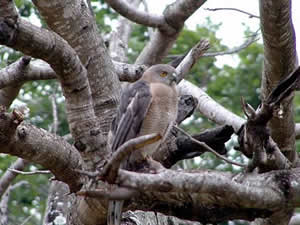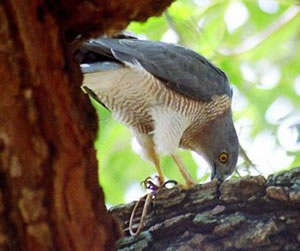Common Birds of India
- Ragoo Rao
Winter is setting in and the cold is bringing in a lot of changes in the birds lives. Now is the season to observe and picture some of the birds which do not migrate but get tuned to a different way of foraging and
roosting.
The warblers are really active in these days foraging for dormant insects early in the mornings. Most of the trees would have shed their leaves and some birds would change their roosting places. The Barbets, specially the Green barbets, which seem to love leafless
trees to look for insects in the bark are very much around with their familiar call .Kutoor....kutoor... call.
This is Nature and the wonderful adaptations of all creatures.
I have selected the Shikra for this month's feature.
 |
A slender pigeon sized raptor is a familiar bird through out the country. Ashy grey above, white below with brown cross barred markings and long slender feet are very familiar around home and avenue trees in urban areas and parks, on
the look out for unwary small birds in trees and lizards and rodents in the grass below. Females are brownish on the upper body. Early mornings, early afternoon and early evenings are its favorite time of preying. They usually sit in leafy trees waiting for
prey and once spotted swoop down silently and carry off the prey. If there are squirrels and magpie robins in the area, they betray their presence by their alarm calls.
The Shikra has a unique flying pattern, rapid wing strokes and a swooping glide below the tree levels and glide up to perch. During nesting the birds frequent their nests, which is usually in a large Mango or Mahogany tree. They can be found carrying small
birds and lizards in their beaks while feeding the chicks.
The shikras are very vocal in the nesting season and their call is a loud warning Ki..Keee...Ki...Keeee. to crows which come close by to the nesting trees. The nest is very much raptor like, with loosely arranged twigs, lined with grass and roots. Three or
sometimes four eggs, bluish white, speckled or spotted with grey are laid. Both sexes share all nesting and chick rearing activities. Incubation is done by only the female bird while the male guards any intruders.
The Shikra occupies a very important niche in the food chain, keeping rodents and lizards in control.
 |
( Photographs of Shikra-Ragoo Rao)
|